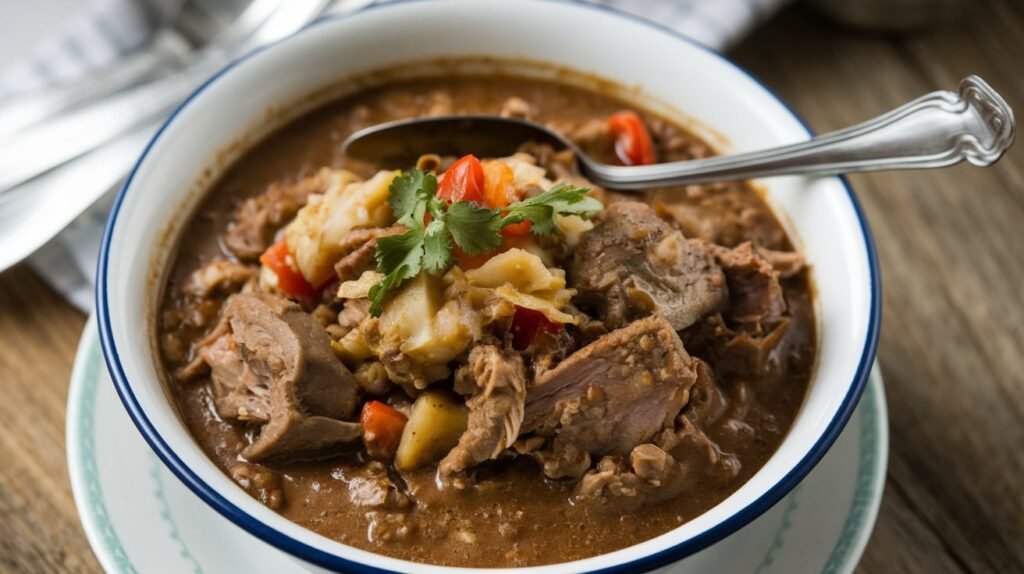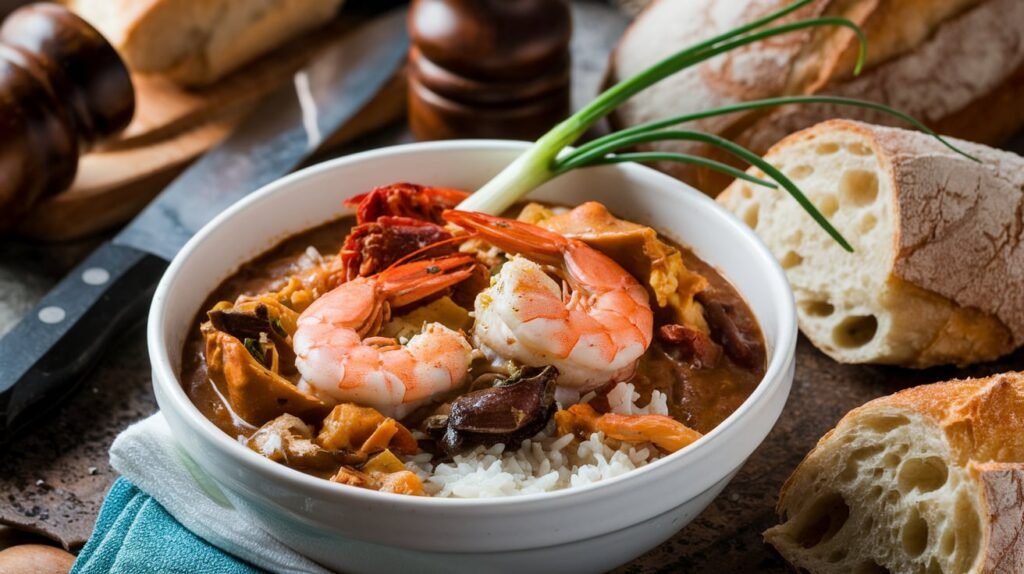Nothing beats the soul-warming comfort of a perfectly crafted filé gumbo recipe that’s been passed down through generations of Louisiana families. This isn’t some fancy restaurant version with complicated techniques – this is real home cooking that captures the essence of Cajun culture in every spoonful.
Gumbo represents the heart of Louisiana cuisine, a dish that brings families together around the dinner table and showcases the incredible diversity of flavors that make Cajun food so beloved. When you master this traditional approach to making gumbo file, you’re not just learning a recipe – you’re connecting with centuries of culinary tradition that defines Southern hospitality.
The beauty of authentic gumbo lies in its simplicity and versatility. At its core, it’s essentially a thick, hearty stew served over rice, but the magic happens in the careful balance of ingredients and the patience required to build deep, complex flavors that make every bite memorable.
Understanding the Difference: Filé vs. Okra Gumbo
Traditional Louisiana gumbo comes in two main varieties, and understanding the difference is crucial for any serious home cook. Filé gumbo uses sassafras powder as its thickening agent, while okra gumbo relies on the natural mucilage from okra pods to achieve that characteristic thick consistency.
Filé powder, made from ground sassafras leaves, was originally introduced by the Choctaw Indians and has become an integral part of authentic Cajun cooking. This earthy, slightly herbal powder not only thickens your gumbo but adds a distinctive flavor that you simply cannot replicate with any other ingredient.
Many Louisiana families swear by filé gumbo because it allows the flavors of the meat and seafood to shine without the sometimes polarizing texture that okra can bring to the dish. The result is a cleaner, more focused flavor profile that highlights the quality of your ingredients.
Essential Ingredients for Authentic Filé Gumbo

The Holy Trinity Base:
- 2 large onions, finely chopped
- 2 celery stalks, diced
- 1 large bell pepper, chopped
- 4 cloves garlic, minced
Protein Components:
- 2 pounds chicken (thighs and drumsticks work best)
- 1 pound andouille sausage, sliced
- 1/2 pound tasso ham (optional but recommended)
Essential Seasonings:
- 3 tablespoons filé powder (sassafras powder)
- 2 bay leaves
- 1 tablespoon Cajun seasoning
- 1 teaspoon dried thyme
- Salt and black pepper to taste
- Cayenne pepper to taste
For the Roux and Base:
- 1/2 cup vegetable oil
- 1/2 cup all-purpose flour
- 8 cups chicken stock
- 2 cups cooked white rice for serving
- Green onions for garnish
The Art of Making Perfect Roux
Creating the perfect roux is absolutely essential for authentic gumbo file, and it’s where many home cooks either succeed brilliantly or fail completely. This mixture of fat and flour serves as both the thickening agent and flavor foundation for your entire dish.
Start by heating your oil in a heavy-bottomed pot over medium heat. Gradually whisk in the flour, creating a smooth paste. This is where patience becomes your best friend – you’ll need to stir constantly for 20-30 minutes as the roux slowly transforms from blonde to deep chocolate brown.
The color development is crucial because it directly impacts the flavor of your finished gumbo. A light roux provides thickening with minimal flavor, while a dark roux contributes deep, nutty notes that define authentic Cajun cuisine. Don’t rush this process, as burned roux will ruin your entire batch.
Roux Color Guide:
- Blonde roux (5-8 minutes): Light thickening, mild flavor
- Brown roux (15-20 minutes): Moderate flavor, good for chicken gumbo
- Dark brown roux (25-35 minutes): Rich, nutty flavor, perfect for seafood gumbo
- Chocolate roux (30-40 minutes): Intense flavor, traditional for authentic gumbo

Step-by-Step Gumbo File Preparation
Building the Flavor Foundation
Once your roux reaches the perfect chocolate brown color, immediately add your chopped onions, celery, and bell pepper. The vegetables will stop the browning process and begin creating the aromatic base that makes Louisiana gumbo so distinctive.
Cook the vegetables in the roux for about 8-10 minutes until they soften and become fragrant. Add the minced garlic during the last minute to prevent burning. This combination, known as the “holy trinity” in Cajun cooking, forms the flavor backbone of virtually every great Louisiana dish.
Adding Proteins and Building Depth
Season your chicken pieces generously with salt, pepper, and Cajun seasoning before adding them to the pot. Brown the chicken on all sides, which typically takes about 12-15 minutes total. This browning step is crucial for developing complex flavors throughout your gumbo.
Add the sliced andouille sausage and tasso ham, cooking for another 5 minutes until the sausage develops some color. The rendered fat from these smoked meats will add incredible depth to your final dish.
Creating the Perfect Consistency
Gradually add your chicken stock, whisking constantly to prevent lumps from forming. Bring the mixture to a rolling boil, then reduce heat to maintain a gentle simmer. Add bay leaves, thyme, and additional Cajun seasoning to taste.
Allow the gumbo to simmer uncovered for 1.5 to 2 hours, stirring occasionally. The liquid should reduce and thicken naturally during this time. Taste periodically and adjust seasonings as needed – remember that flavors will concentrate as liquid evaporates.
The Crucial Role of Filé Powder
Here’s where many home cooks make a critical mistake with their gumbo file technique. Filé powder should never be added while the gumbo is actively cooking, as high heat will make it stringy and unpalatable. Instead, add the filé powder after removing the pot from heat.
Stir in 2-3 tablespoons of filé powder gradually, tasting as you go. The powder will continue thickening the gumbo even after cooling, so don’t overdo it initially. You can always add more, but you cannot remove excess filé once it’s incorporated.

Some families prefer to serve filé powder at the table, allowing each person to add their preferred amount to individual bowls. This approach prevents the entire pot from becoming too thick if there are leftovers.
Regional Variations and Adaptations
Seafood Gumbo File
While this recipe focuses on chicken and sausage, the same basic technique works beautifully with seafood. Replace the chicken with shrimp, crab, and oysters, adding them during the last 10-15 minutes of cooking to prevent overcooking.
Seafood gumbo typically uses a darker roux and benefits from seafood stock instead of chicken stock. The filé powder works exactly the same way, providing thickening and that distinctive Louisiana flavor profile.
Duck and Andouille Variation
For special occasions, many Louisiana families prepare gumbo using wild duck or domestic duck instead of chicken. The rich, gamey flavor pairs beautifully with andouille sausage and creates an incredibly satisfying cold-weather meal.
Duck requires slightly longer cooking time, but the technique remains identical. The rendered duck fat adds extraordinary richness that elevates this humble stew into something truly special.
Common Mistakes and How to Avoid Them
Burned Roux Recovery
If your roux burns, there’s unfortunately no salvaging it – you’ll need to start over completely. Burned roux will impart bitter flavors that will ruin your entire batch of gumbo. Keep the heat at medium and stir constantly to prevent this frustrating setback.
Overly Thick or Thin Consistency
Gumbo should coat the back of a spoon but still pour easily. If your gumbo becomes too thick, add hot stock gradually until you reach the desired consistency. If it’s too thin, continue simmering uncovered to reduce liquid, or make a small amount of additional roux to stir in.
Filé Powder Timing Issues
Remember that filé powder must be added off the heat. If you accidentally add it while cooking, the texture will become unpleasantly stringy. There’s no fixing this mistake – prevention is the only solution.
Serving and Storage Recommendations
Traditional Presentation
Serve your gumbo file over fluffy white rice in deep bowls, garnished with chopped green onions. Many Louisiana families also provide hot sauce and additional filé powder at the table for individual customization.
The rice should be freshly cooked and fluffy, providing a neutral base that absorbs the rich gumbo flavors without competing for attention. Long-grain white rice works best for this traditional presentation.
Storage and Reheating
Gumbo actually improves in flavor after a day or two in the refrigerator, making it perfect for meal preparation. Store in airtight containers for up to 4 days, or freeze for up to 3 months.

When reheating, add a small amount of stock if the gumbo has thickened too much during storage. Heat gently to prevent the filé from becoming stringy, and avoid boiling reheated gumbo.
The Cultural Significance of Gumbo
Understanding gumbo means appreciating the cultural melting pot that created Louisiana cuisine. This dish represents the convergence of French cooking techniques, African ingredients and methods, Spanish influences, and Native American contributions like filé powder.
Each family’s gumbo recipe tells a story of heritage, adaptation, and tradition. While techniques may vary slightly from household to household, the commitment to quality ingredients and patient preparation remains constant across generations.
Troubleshooting Your Gumbo File
Achieving Proper Seasoning Balance
Great gumbo requires careful attention to seasoning throughout the cooking process. Taste frequently and adjust salt, pepper, and cayenne as the flavors develop. Remember that the liquid will concentrate during cooking, so initial seasoning should be slightly milder than your target flavor.
Protein Cooking Guidelines
Chicken should be tender enough to fall off the bone, while sausage should be heated through and slightly browned. Overcooking will make proteins tough and chewy, while undercooking poses food safety risks.
Conclusion
Mastering an authentic filé gumbo recipe connects you to generations of Louisiana home cooks who understood that the best comfort food comes from patience, quality ingredients, and time-honored techniques. This isn’t fast food – it’s slow food that rewards careful attention with incredible flavors.
The beauty of traditional gumbo file lies in its versatility and forgiving nature. Once you understand the basic principles of roux-making and proper filé powder usage, you can adapt this recipe to include whatever proteins and vegetables you prefer, creating your own family tradition while honoring the cultural heritage that makes this dish so special.
Whether you’re cooking for a Sunday family dinner or preparing for a special celebration, this authentic approach to gumbo will deliver the kind of soul-satisfying results that keep people coming back for seconds and asking for the recipe.


